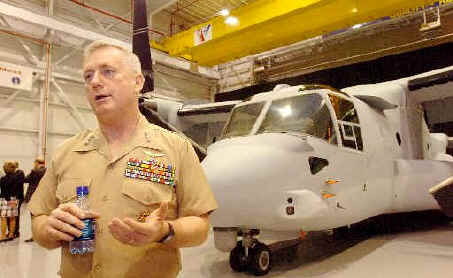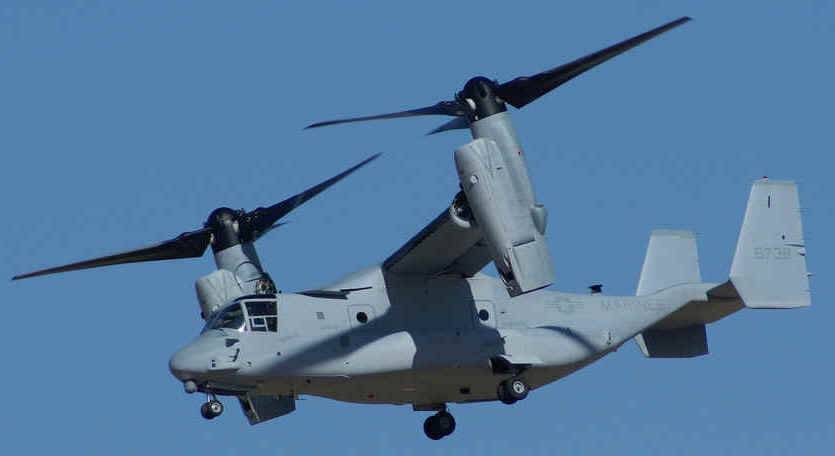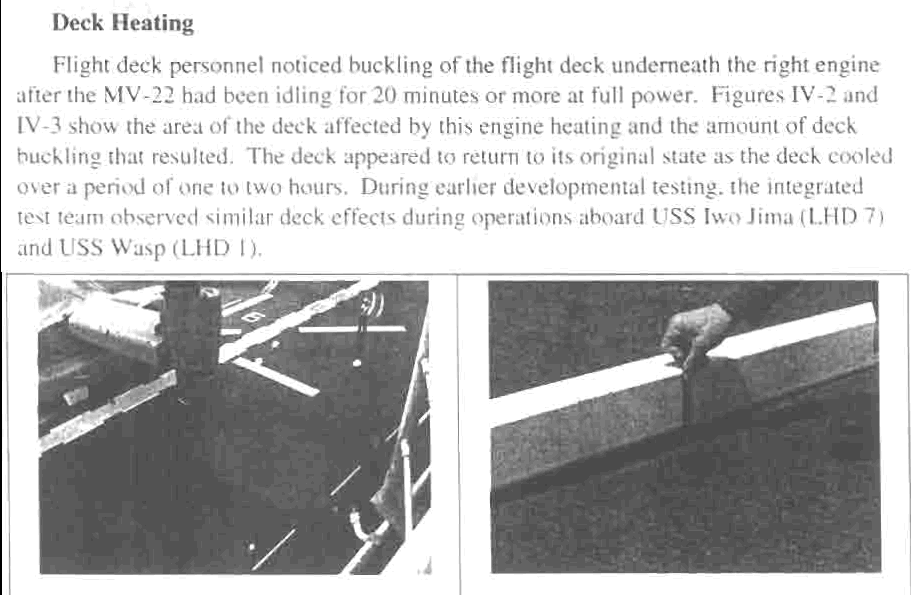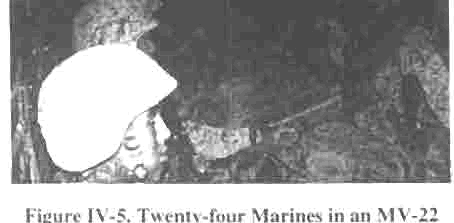There have been numerous stories in recent years about the Pentagon's dysfunctional procurement system. It has now reached a point where dozens of new aircraft go missing. This case involves the troubled V-22 Osprey program. At least 40 of those purchased for the Marine Corps, the MV-22s, are missing or were secretly scrapped!
In May, Congress responded to reports from reliable sources that dozens of new V-22s were damaged and hidden in hangars. One insider specifically said that 27 broke down MV-22s are hidden at the Marine Corps Air Station New River, North Carolina -- "in the hangar by ops, where the C-12s are parked." V-22 maintainers reported that they have cannibalized parts from MV-22s in that hangar for years, and the number of aircraft stashed there continues to grow.
Additional evidence appeared in the Marine Corps' FY 2009 Aviation Plan (pdf), published on Oct. 1, 2008. That detailed plan lists a total inventory of 67 MV-22s, plus 4 in depots. A quick check of Pentagon budgets reveals that Congress funded 126 MV-22s for the Marines through FY2008. The first 10 MV-22s were development and test aircraft that were retired or crashed. Two of the production models, called the MV-22B, also crashed, so the Corps should have had 114 MV-22Bs when the FY2009 Aviation Plan was published, yet reported an inventory of just 71. While delayed deliveries explain most of these 43 "missing" MV-22s, some Congressmen and the GAO took interest. The GAO conducted a review to determine the status and readiness of the MV-22B fleet. (Note: most MV-22Bs have been upgraded to Block A or Block B configurations.)
The Marine Corps refused to provide the GAO with access to its detailed records on the status of its MV-22 fleet. As a result, on May 5, 2009 the House Committee on Oversight and Government Reform demanded that the Marine Corps provide an inventory list of its MV-22Bs along with the location, status, and readiness levels the past two years. The Marine Corps refused to provide any data, claiming that it was classified and release must be approved by the Department of Defense. The specific office or person at DoD who was withholding data was never identified.
 The Committee
scheduled a hearing for May 23, 2009 to address these concerns and hear
testimony from the Marine Corps about these issues. The data had not been
provided to the committee by that date, so the chairman rescheduled the hearing
for a month later and warned that if the data was not provided, he would use subpoena
power to acquire it. Among those invited to appear at the hearing was the
head of Marine Corps Aviation, Lieutenant General George Trautman. In his
prepared testimony for the delayed hearing, Trautman stated that: "We have accepted
delivery of 91 Ospreys, a quarter of our program objective of 360
aircraft."
The Committee
scheduled a hearing for May 23, 2009 to address these concerns and hear
testimony from the Marine Corps about these issues. The data had not been
provided to the committee by that date, so the chairman rescheduled the hearing
for a month later and warned that if the data was not provided, he would use subpoena
power to acquire it. Among those invited to appear at the hearing was the
head of Marine Corps Aviation, Lieutenant General George Trautman. In his
prepared testimony for the delayed hearing, Trautman stated that: "We have accepted
delivery of 91 Ospreys, a quarter of our program objective of 360
aircraft."
General Trautmen forgot that he spoke at a ceremony for the delivery of the 100th V-22 back in March 2008. The local paper in Amarillo printed a story along with Trautman's picture in front of the 100th V-22. That was over 14 months prior to this hearing, and two dozen more Ospreys had been delivered when he provided written testimony to Congress that only 91 had been delivered. MV-22B No. 103 (166738) is pictured below flying in February 2009. This was the 103rd MV-22B delivered to the Marine Corps, a tally that does not include CV-22s delivered to the Air Force.

A couple weeks later, Marine Corps officers met with committee staff and provided some information, but not the four huge binders of data they said was stuck in the Pentagon. This indicated that as of June 3, 2009, 105 MV-22 "Osprey" had been delivered to the Marine Corps since 1988. Only 47 are combat deployable; 29 are not usable (includes experimental, damaged, destroyed, or otherwise unflyable); 27 are useable only for pilot training; and two paid for but not delivered. Of the 47 combat deployable, only 22 were mission capable on June 3, 2009. According to a June 19, 2009 internal memorandum from the committee staff:
"The Committee staff encountered major difficulties in attempting to determine the answer to what might ordinarily seem like an obvious question: How many Ospreys does the Marine Corps have and what is their flight status? The Defense Department seemed to have serious difficulty in assembling this information.
...on May 28, 2009, the Committee received a partial document production of four small binders, and on June 2, 2009, staff met with Marine Corps officers who provided additional documents that filled some of the information gaps remaining from the initial production regarding inventory. During the June 2 meeting, staff again requested internal memoranda concerning the operational status of the MV-22 fleet and received a second production, a single binder, on June 5, 2009. 'We do not believe that the total of five binders produced to the Committee represents the full universe of responsive records."
The data provided to the committee indicated that 105 MV-22s had been delivered as of June 3, 2009, a total that included the first ten retired after testing and development and two production MV-22s stricken after dramatic crashes. While the Marine Corps pretends that a list of its MV-22s must remain secret, excellent lists can be found on the Internet at Target Lock and Helis, which indicate the Marines should have far more than 105. As result, the committee asked the Congressional Research Service to tally up the total number of MV-22s funded for the Marine Corps the past 22 years. Meanwhile, the committee hearings were held in late June where attention focused on the MV-22's poor readiness rates.
The report from the Congressional Research Service appeared in June, and states: "Through FY2009, a total of 181 V-22s have been procured—155 MV-22s for the Marine Corps, and 26 CV-22s for USSOCOM. These totals include several V-22s that have been procured in recent years through wartime supplemental funding that has been provided in addition to DOD’s regular (aka “base”) budget."
 That is a summary of public budget documents
proving that Congress funded 155 MV-22s for the Marines through FY2009, which
ends Sept. 30, 2009. Congress funded 30 MV-22s
for FY2009, so Bell is delivering around 2.5 aircraft a month. June 3rd was four
months before the end of FY2009, so 10 V-22s had yet to be delivered, so the
Corps should have had around 145 MV-22s on the date it told Congress 105 had
been delivered, a number that included those stricken. However, aircraft
delivery usually lags several months behind the year procured. However, Bell
recently claimed that V-22 production is ahead of schedule. Since the Marine
Corps has yet to produce a detailed status list of the 155 funded, 40
MV-22s are unaccounted for. Where are they?
That is a summary of public budget documents
proving that Congress funded 155 MV-22s for the Marines through FY2009, which
ends Sept. 30, 2009. Congress funded 30 MV-22s
for FY2009, so Bell is delivering around 2.5 aircraft a month. June 3rd was four
months before the end of FY2009, so 10 V-22s had yet to be delivered, so the
Corps should have had around 145 MV-22s on the date it told Congress 105 had
been delivered, a number that included those stricken. However, aircraft
delivery usually lags several months behind the year procured. However, Bell
recently claimed that V-22 production is ahead of schedule. Since the Marine
Corps has yet to produce a detailed status list of the 155 funded, 40
MV-22s are unaccounted for. Where are they?
In contrast, the U.S. Air Force's C-17 transport fleet is roughly the same age as the MV-22s. Around 188 have been delivered as of June. Only one is unflyable as it undergoes repairs after a landing accident in Afghanistan last January. C-17s have mission capable rates above 85%, and none are "missing." One can speculate as to why 40 MV-22s are hidden. Perhaps they suffered serious damage that was never reported, and were quietly retired, or "preserved" as they are called at New River. It is also possible that some were defective, yet the Marines accepted delivery, Bell-Boeing was paid, and the aircraft stripped of parts and stuffed in a hangar at the Amarillo factory. It is also possible that ready "spare MV-22s" exist off-the-books to quickly replace broke down squadron aircraft to bolster mission capable rates. This is just speculation, only an investigation will uncover the truth.
The Secretary of Defense should order his Inspector General to find these 40 missing MV-22s. Each aircraft has a unique tail number with its assigned Navy bureau number. It also has a metal plate with its contract number. There are 10 MV-22s deployed aboard the USS Bataan, the rest are in the USA. Counting them should take just a couple of weeks, assuming they all exist. If they can't be found, a Marine Corps database tracks the chain-of-custody for all major items of equipment that lists the officer who signed for each aircraft.
Hopefully, the United States has not become a Banana Republic where major items of military equipment disappear and everyone is afraid to ask why. If the Pentagon refuses to act, Congress should demand that the FBI to track down this $4 billion of missing aircraft. Meanwhile, Congress should refuse to fund any more V-22s until an accounting is provided, something the Marine Corps can provide in a matter of hours.
 Investigators must also determine why the Marine
Corps' list of 105 includes 29 fairly new MV-22s as "unflyable"
and permanently grounded. As noted above, eight of the
test and development aircraft have been retired, two others crashed, and two
production MV-22s crashed. That accounts for 12 unflyable aircraft, so how
did another 17 MV-22s become unflyable? Why can't they be fixed? How many
new MV-22s become unflyable each year?
Investigators must also determine why the Marine
Corps' list of 105 includes 29 fairly new MV-22s as "unflyable"
and permanently grounded. As noted above, eight of the
test and development aircraft have been retired, two others crashed, and two
production MV-22s crashed. That accounts for 12 unflyable aircraft, so how
did another 17 MV-22s become unflyable? Why can't they be fixed? How many
new MV-22s become unflyable each year?
The Marine Corps told the committee staff that five of its MV-22s were too expensive to repair and six other unrepairables were reclassified as ground school trainers. (Two of the scrapped $100 million "school trainers" at New River are pictured.) Were Class A mishaps reports filed and JAG investigations conducted, which is required whenever more that $1 million in damage is sustained? According to the public archives at the Navy Safety Center, only two V-22 Class A mishaps were reported since the two crashes in 2000 - an engine fire and a broken wing.
The entire V-22 fleet averages two years of age and are mission capable half the time, and a "full mission capable" V-22 is a rare occurrence. While the 40-year old CH-46Es have around 10,000 flight hours and higher readiness rates, Marine Corps documents refer to serious problems with "high time" MV-22Bs, i.e. those with more than 500 hours of flight time. It seems V-22s have a service life of less than four years before they are retired.
Carlton Meyer editorG2mil@Gmail.com
©2009 www.G2mil.com
July 10, 2009 Update:
A Marine Corps public affairs officer offered to "try" to provide a current list of the Corps' MV-22 fleet. Others noted that delivery of aircraft often occurs several months after the fiscal year they were funded. Here is a photo of MV-22 No. 98 assigned to an operational squadron (VMM-261) in transit on March 15, 2009, the day after the 100th V-22 was delivered.
The MV-22s 62% mission capable rate in Iraq meant those aircraft that could fly. The "full mission capable" rate for these new aircraft after 25 years of development was 6%. The readiness rate for MV-22s back in the USA was even lower. These problems were identified during the 2005 OPEVAL, where the V-22 failed two of five maintenance readiness requirements. It should have failed all of them because one of the six MV-22s had a serious engine fire, so rules were broken and it was swapped out with another aircraft. The OPEVAL noted problems with lightweight composite parts.

Marines were overwhelmed by the frequency of parts to repair, so they recently adopted a policy of disposing of any repairable part that cost less than $10,000. Meanwhile, the program says it solved the deck heating problem. Sailors will place heat shields under the engines. http://www.navair.navy.mil/v22/index.cfm?fuseaction=news.detail&id=213
How do sailors move these big heat shields around, carry them? Isn't that dangerous on a windy deck with lots of downwash. I suppose they must be tied down to the deck. Will people trip over them? Do ships need more crewmen just to perform this task? Where do they store these big shields? Will they wear out after a few hours of use?The extent of this problem has been known
since 1999. The OPEVAL has a picture of a dip in the flight deck several inches
deep after just 20 minutes of sitting on an LHD, which didn't reform until after
two hours.
 Another
ignored issue is the hazard of refueling aircraft while V-22 engines torch the
flight deck. Sailors drag heavy fuel hoses between aircraft while wearing
hearing protection and enduring poor lighting, high winds, and fatigue. What
happens when a fuel hose is dragged too close to a V-22's searing engine
exhaust? One General suggested that V-22s can reduce deck heating by tilting
their rotors slightly forward. This helps, although several sailors and Marines
will literally lose their heads each year as they stray into the huge spinning
proprotors. In addition, persons or aircraft aft of a tilted tiltrotor would
face gale force blasts of hot air.
Another
ignored issue is the hazard of refueling aircraft while V-22 engines torch the
flight deck. Sailors drag heavy fuel hoses between aircraft while wearing
hearing protection and enduring poor lighting, high winds, and fatigue. What
happens when a fuel hose is dragged too close to a V-22's searing engine
exhaust? One General suggested that V-22s can reduce deck heating by tilting
their rotors slightly forward. This helps, although several sailors and Marines
will literally lose their heads each year as they stray into the huge spinning
proprotors. In addition, persons or aircraft aft of a tilted tiltrotor would
face gale force blasts of hot air.
Finally,
page 34 shows 24 "combat equipped" Marines in an MV-22. This PDF copy
is hard to see, but note that their knees are interlocked, so egress is
difficult and crew chiefs cannot move around. The V-22's cabin is six inches
narrower than the CH-46E and six inches lower. Also note these "combat
equipped" Marines only have rifles, no backpacks or other gear. The
contract stated that 240 lbs must be counted for each combat equipped Marine,
yet the bogus OPEVAL used small Marines with little gear to get their average
weight down to 198 lbs so the V-22 could pass the range required. 
The GAO once determined that only 15-18 Marines will fit, but then you can cram 10 people in a phone booth. V-22s in Iraq never carried close to 24 Marines. The GAO was told this is because body armor and other gear requires an estimate of 300-400 lbs for each Marine. Worst of all, even if the Corps ever gets the 7.62mm retractable belly guy to work, it must retract for landing. leaving the aircraft defenseless for three minutes while packed Marines untangle themselves. The OPEVAL noted:

In contrast, helicopters have side-mounted machine guns that provide excellent grazing fire during this vulnerable period. They even have windows so that troops inside can fire rifles while waiting to egress. In his two excellent books, J. Stryker Meyer describes his two tours as a Green Beret in Vietnam where he frequently engaged in short fire fights with insurgents by firing out helicopter windows during landings and take-offs.